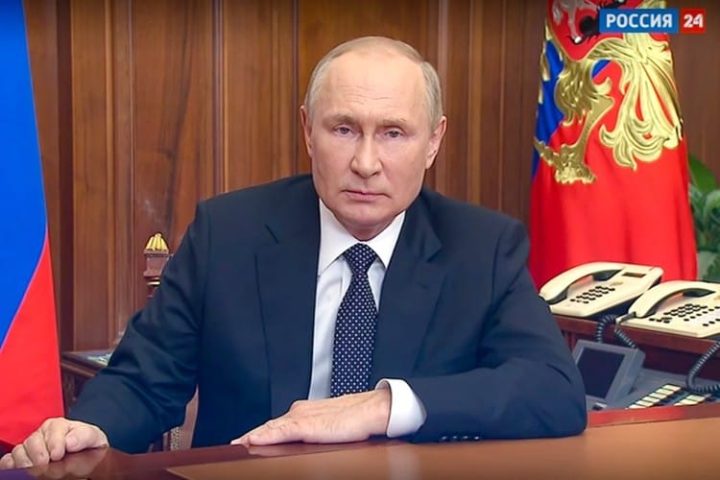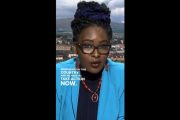
Eight months into the invasion of Ukraine, Russian President Vladimir Putin announced a partial military mobilization of up to 300,000 Russian men, signaling the war in the geographical hub of Europe will continue.
In his first public address since the beginning of the “special military operation” for the “demilitarization and de-Nazification of Ukraine” on February 24, Putin stressed that the Russian army is fighting not just against the “neo-Nazi forces” of the Kiev regime but “against the whole war machine of the collective West” seeking to annihilate Russia.
“The goal of the West is to weaken, divide, and destroy our country,” Putin opened his speech. To prove his argument, he went on to blame the West for destroying the communist, totalitarian, godless Soviet Union, which he often praises. “They are openly saying that in 1991 they split the Soviet Union, and now it’s Russia’s turn, and she must dissolve into numerous rival regions and areas.”
To “adequately counter” this threat, Putin issued an order to immediately start a “partial mobilization” of those citizens “who are currently in the reserves and, above all, those who have served in the armed forces [and] have military skills and relevant experience.”
Under Russian law, men aged 18-27 are obligated to military service, typically for one year. Yet there are numerous loopholes allowing for medical and educational exceptions, with many young men bribing the local authorities to dodge the recruitment.
According to Putin’s order, up to 300,000 men will be sent to the occupied Ukrainian regions of Donetsk and Luhansk and to the partially controlled territories of Kherson and Zaporizhzhia.
“The line of contact, which may be called the frontline, is more than 1,000 km [600 miles] long,” explained Russian Defense Minister Sergei Shoigu, speaking after his boss. “Naturally, everything behind that line needs to be protected, [and] all these territories need to be controlled. That’s the main goal of this effort, of the partial mobilization.”
Notably, Russia has not yet declared war on Ukraine, and keeps calling the invasion a “special military operation.”
Putin also affirmed his support for referendums in a number of Ukrainian regions currently occupied by Russia.
The move comes almost two weeks after the army suffered a military defeat in northeastern and southern Ukraine, with troops fleeing from about a tenth of the territory Russia had captured.
On Monday, the breakaway Ukrainian republics of Donetsk and Luhansk adopted resolutions to schedule a referendum on the unification with the Russian Federation for September 23–27. Kherson and Zaporizhzhia will be holding similar events on the same dates.
Putin addressed these developments, reassuring that Russia would do “everything” to make the referendums secure.
Months after targeting civilian infrastructure and killing Ukrainian civilians, Putin said that Russia “has no moral right to surrender our people to the butchers [and] cannot ignore their genuine plea to independently decide on their destiny,” adding that Russia would support any decision made by the aforementioned regions.
During his speech, Putin yet again alluded to Russia’s nuclear weaponry that he would decisively use if need be.
In the event of a threat “to the territorial integrity of our country and for the defense of Russia and our people, we will certainly use all the means that we have. This is not a bluff,” he warned, closing his speech.
During the invasion, Russian territory was repeatedly targeted by Ukraine, including the Belgorod and Kursk regions, as well as Crimea, which Russia considers a part of her territory but has drawn little but condemnation from Russia.
Under Pressure
Russia is stuck in Ukraine for much longer than most expected, despite having the “second strongest army in the world.” Systemic corruption, poor planning and organization in the Russian military, and generous military support of Ukraine from the West all have played a major role in prolonging the bloody conflict that is taking a heavy toll on ordinary folks in Ukraine, Russia, Europe, and elsewhere.
Now, as winter approaches with momentum appearing to be on Ukraine’s side, Russia is trying to compensate for its losses with manpower.
According to the BBC report,
Russia’s initial invasion force in February numbered about 190,000 troops, in addition to thousands of pro-Russian fighters in the Donbas region.
The Kremlin launched a massive recruitment drive, offering big financial incentives. So extra troops were drafted in, especially from poor regions of Siberia and the Caucasus, including experienced Chechen fighters.
Russia has a normal limit of just over a million military personnel and almost 900,000 civilian staff — but last month President Putin signed a decree to recruit 137,000 more.
It was previously reported that Russia was recruiting homeless people, prisoners, and even mental-hospital patients to fight in Ukraine.
Last week, the Duma, the lower house of the Russian parliament, passed a law introducing the concepts of “mobilization,” “martial law,” “war time,” and “armed conflict” into the Russian criminal code. The legislation also amends the articles related to voluntary surrender, not appearing for conscription, and desertion. The Russian Federal Council, the upper house, backed the bill on Wednesday, which now goes to Putin to be signed into law.
NATO was quick to pick up the gauntlet.
“We are prepared for a hard winter. The winter is coming, it’s going to be hard for all of us. But the answer is not to step down and to stop supporting Ukraine. The answer, if anything, is to step up and further support Ukraine,” Jens Stoltenberg, NATO’s secretary-general, told Reuters.
Both sides are arguably willing to escalate the conflict, meaning more loss of life, more economic devastation, and more chaos. These are the best conditions for establishing political control and authority over the desperate populace.




